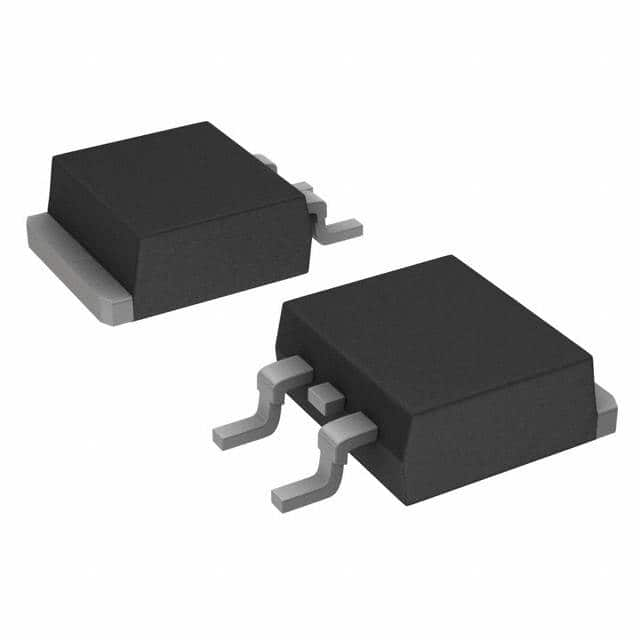IRFZ44RSTRR
Product Overview
Category
The IRFZ44RSTRR belongs to the category of power MOSFETs.
Use
It is commonly used in electronic circuits for switching and amplification applications.
Characteristics
- High current handling capability
- Low on-resistance
- Fast switching speed
- Low gate drive power
Package
The IRFZ44RSTRR is typically available in a TO-220AB package.
Essence
This MOSFET is essential for controlling high-power loads in various electronic devices and systems.
Packaging/Quantity
It is usually packaged in reels or tubes, with quantities varying based on manufacturer specifications.
Specifications
- Drain-Source Voltage (VDS): 60V
- Continuous Drain Current (ID): 50A
- RDS(ON) (Max) @ VGS = 10V: 0.028Ω
- Gate-Source Voltage (VGS) (Max): ±20V
- Total Power Dissipation (PD): 94W
Detailed Pin Configuration
The IRFZ44RSTRR has three pins: 1. Gate (G): Used to control the flow of current between the source and drain. 2. Drain (D): Connects to the positive side of the load. 3. Source (S): Connects to the ground or negative side of the load.
Functional Features
- High current handling capacity makes it suitable for power applications.
- Low on-resistance minimizes power loss and heat generation.
- Fast switching speed enables efficient operation in switching circuits.
Advantages
- Suitable for high-power applications
- Low on-resistance reduces power dissipation
- Fast switching speed enhances efficiency
Disadvantages
- May require careful handling due to its high current capabilities
- Sensitivity to static electricity can pose risks during handling and installation
Working Principles
The IRFZ44RSTRR operates based on the principles of field-effect transistors, where the voltage applied to the gate terminal controls the flow of current between the source and drain terminals. When a sufficient voltage is applied to the gate, the MOSFET allows current to flow through, enabling the controlled switching of high-power loads.
Detailed Application Field Plans
The IRFZ44RSTRR finds extensive use in various applications, including: - Motor control circuits - Power supply units - Audio amplifiers - LED lighting systems - Switching regulators
Detailed and Complete Alternative Models
Some alternative models to the IRFZ44RSTRR include: - IRFZ44N - IRFZ48 - IRFZ46 - IRFZ42
In conclusion, the IRFZ44RSTRR is a versatile power MOSFET with high current handling capabilities, low on-resistance, and fast switching speed, making it suitable for a wide range of electronic applications.
[Word count: 394]
Senaraikan 10 soalan dan jawapan biasa yang berkaitan dengan aplikasi IRFZ44RSTRR dalam penyelesaian teknikal
What is the maximum drain-source voltage of IRFZ44RSTRR?
- The maximum drain-source voltage of IRFZ44RSTRR is 60V.
What is the continuous drain current rating of IRFZ44RSTRR?
- The continuous drain current rating of IRFZ44RSTRR is 49A.
What is the on-state resistance (RDS(on)) of IRFZ44RSTRR?
- The on-state resistance (RDS(on)) of IRFZ44RSTRR is typically 17mΩ at VGS = 10V.
Can IRFZ44RSTRR be used for switching applications?
- Yes, IRFZ44RSTRR is suitable for switching applications due to its low on-state resistance and high drain-source voltage rating.
What is the gate-source voltage (VGS) required to fully enhance IRFZ44RSTRR?
- The gate-source voltage (VGS) required to fully enhance IRFZ44RSTRR is typically 10V.
Is IRFZ44RSTRR suitable for automotive applications?
- Yes, IRFZ44RSTRR is commonly used in automotive applications such as motor control and power distribution.
What are the typical thermal characteristics of IRFZ44RSTRR?
- The typical thermal resistance from junction to case (RθJC) of IRFZ44RSTRR is 1.0°C/W.
Does IRFZ44RSTRR require a heatsink for high-power applications?
- Yes, for high-power applications, it is recommended to use a heatsink to dissipate heat effectively.
What are the common failure modes of IRFZ44RSTRR?
- Common failure modes of IRFZ44RSTRR include overcurrent, overvoltage, and thermal overstress.
Can IRFZ44RSTRR be used in parallel to increase current handling capability?
- Yes, IRFZ44RSTRR can be used in parallel to increase the overall current handling capability in certain applications. However, proper attention should be given to current sharing and thermal management.


